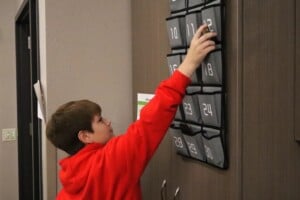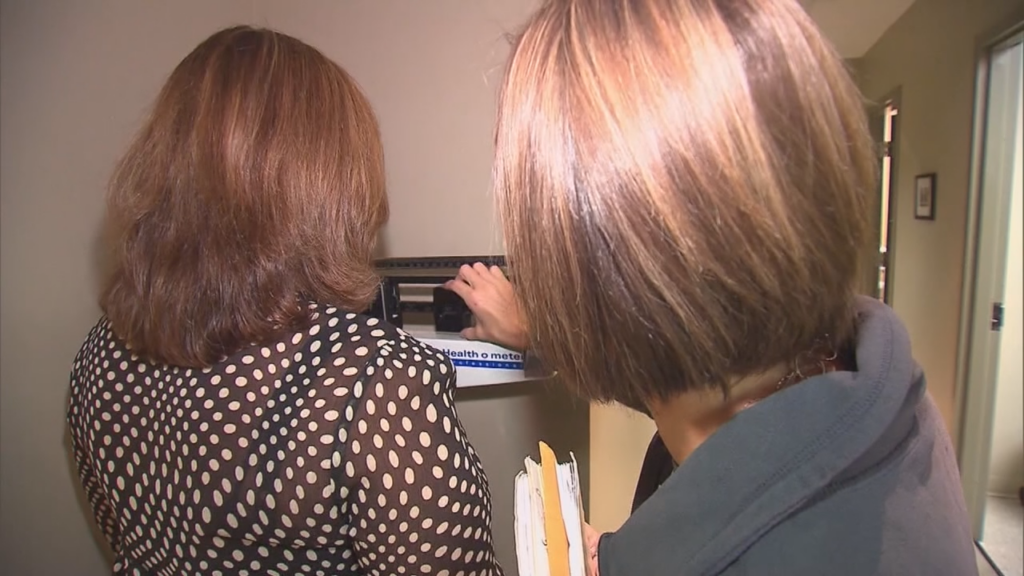Cellphone ban means less drama, more focus for some North Dakota students

BISMARCK, N.D. (North Dakota Monitor) – As students entered their classrooms at Simle Middle School in Bismarck Wednesday morning, they instinctively went to the back of the room where a wall hanger with numbered pockets was attached to a cupboard door, waiting for their cellphones.
They slipped their phones into one of the numbered slots, one after another, and then took their seats.
No fuss. No comments. Straight into the business of the school day.
North Dakota schools implemented a bell-to-bell cellphone restriction for the 2025-26 school year after state lawmakers passed the ban during the 2025 legislative session with the backing of Gov. Kelly Armstrong.
Some schools needed to craft new cellphone policies from scratch, but others, like Simle Middle School, had restricted phones last year, which lessened the impact of the new law, said Randy Lamberth, assistant principal for the middle school.
“Ultimately, what we see is kids have their heads up in the hallway,” Lamberth said.
Last year’s school policy forced kids to have their phones stowed in a locker or backpack, and the change for them this year was turning the phones into faculty at the start of the day and picking them up at the end of the day.
“There’s not a lot of pushback from our kids,” Lamberth said. Disciplinary actions for student phone use have been minimal during the first month of classes, he said.
Serenity Horne, 14, eighth grader at Simle Middle School, said not much has changed in the cellphone rules between last year and this year.
“It’s been a lot less drama-wise,” Horne said. “There were a lot of kids last year that went to the bathroom to use their phones and now we don’t have that.”
She said she’s noticed the teachers getting more attention from students and she also feels more focused during the school day.
Charlie Reich, 12, seventh grader at Simle Middle School, said he has also noticed students seem to be more focused.
“It feels normal,” Reich said. He added he thinks not having his phone during school hours will help him be a better student.
Bismarck Public Schools Superintendent Jeff Fastnacht said administrators around the district thought the new cellphone policy was going to be a “tough sell” for kids and parents.
“That didn’t materialize the same way that was maybe predicted,” Fastnacht said.
He said only about 50 disciplinary incidents have been reported at Bismarck schools.
“That’s districtwide. That’s 14,000 kids,” Fastnacht said. “That’s miniscule.”
He said the district has seen an increase in medical exemption requests from parents who want their kids to still have access to their phones during the day to monitor medical conditions, and the district is accommodating those requests.
When asked if he believed the law needed to be changed at all during the next legislative session, Fastnacht said lawmakers could clarify what type of medical professionals can authorize a medical exemption for cellphone use.
“Who should be that prescribing doctor that says you need to have access to your phone?” he said. “The law pretty much says it can be whatever they provide us.”
Some schools in the district have rolled a board game and puzzle cart into their lunch rooms to give students more entertainment while they eat and socialize, which used to be a time when students would scroll on their phones, Fastnacht said.
Audra Zimmerman, principal at Williston Middle School Central Campus, said cellphones were rooted in many of the behavioral problems they were seeing two years ago at the school of about 1,600 students.
“All the fights, and they were recording everything. It was causing a huge disruption,” Zimmerman said.
To address those problems, the district restricted cellphone use by students last year and required them to check them in with their homeroom teachers at the beginning of the day, she said. If students were caught with devices, they would be warned, and if they were caught again the phones would be turned into the office for a parent to pick up.
With the new state law, the discipline has become more strict and the warnings have been tossed out, Zimmerman said. This year, students caught with their cellphones are immediately met with an in-school suspension, she said.
She said she has also heard criticism from parents this year about teachers being on their phones during the school day. Zimmerman pointed out that teachers need to have their phones because the school uses them to issue emergency alerts.
“If we need a team member to assist a student, if we need a team member to assist another staff member, or there is a medical emergency, it’s all communicated through phones,” she said.
Williston High School Principal Audrey Larson said teachers are not having to constantly battle students over using their phones. Administrators have taken on a little more of an enforcement role, but they expected that role to increase in the lead-up to the school year.
But, she said the cellphone incidents have been decreasing at the high school as the weeks roll by.
“I think the first few weeks, obviously, we saw a little bit more, but as kids hear that it’s serious, it’s been less and less all the time, so that’s positive because kids are learning,” Larson said. “We’re seeing much less of the Snapchat drama than we used to.”
By Michael Achterling.






